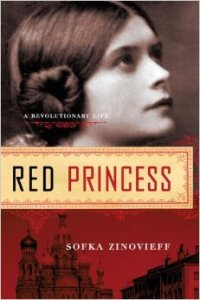Четверг 4 июня 2015, 19:00
Thomas Gray Room, Pembroke College, Trumpington Street, Cambridge
Вход: £3; члены КемРусса — бесплатно.
[This family is *NOT* related to Grigory Zinoviev, whose original name was Ovsei-Gershon Radomyslsky, a member of the first Politburo (1917), who was executed under Stalin in 1936.]
The father & daughter duo Zinovieffs will talk about their Russian roots and family history. Their family tree can be traced back to the 13th century and is full of Russian nobility names like Dolgorouky, Bobrinskiy and others close to Tzar’s High court.
Sofka Zinovieff has published a book about her extraordinary grandmother, who was also called Sofka.
About the Book: “In 1907 Princess Sophy (‘Sofka’) Dolgorouky was born in St.Petersburg. Members of the Imperial family had attended her parents’ wedding earlier that same year, and the child was born into a privileged world of nurses, private tutors and elegant tea parties. The Russian Revolution caused the princess to flee across Europe to England, but it was the Second World War that left the deepest marks on her adult life. During those years, she left her first husband and lost her second. Later, she was interned in a Nazi prison camp, where she discovered Communism and showed great bravery in defending the rights of the Jewish prisoners.
It was her Communism which took her back to the Soviet Union as an improbable tour guide for British workers. And Communism, albeit indirectly, brought her the last love of her life, Jack, a working-class Londoner who had never been abroad. Sofka’s colourful life also included a close friendship with Laurence Olivier, innumerable lovers, some serious, some quickly discarded, and an abiding love of reading and especially poetry.
This affectionate portrait of the ‘red princess’ by her granddaughter and namesake uses letters, diaries and interviews to recreate a vanished world and also explore the author’s own Russian roots.” (from the Amazon listing)
Peter Zinovieff is a British engineer and inventor, most notable for his Electronic Music Studios (EMS) company, that made the famous VCS3 synthesizer in the late 1960s which was used by many early progressive rock bands such as Pink Floyd and White Noise. Dr Zinovieff, geologist, librettist and adventurer in sound and music, was the first person to own a ‘computer’ at home, as his huge synthesiser was a type of computer, long before the modern PC or Mac. At EMS, he helped design and build the acclaimed VCS and Synthi series, which have now become the stuff of legend and the dreams of collectors.
From The Guardian Book Review:
 Sofka Zinovieff’s grandmother was a White Russian aristocrat in flight from the political upheavals of the 20th century. Like many exiles for whom tomorrow is a hostile land, the eponymous Red Princess — also known as Sofka — lived life with the gusto of the desperado. Her biography, as a result, is a union of comedy and tragedy infused with the heady romance of a vanished Russia.
Sofka Zinovieff’s grandmother was a White Russian aristocrat in flight from the political upheavals of the 20th century. Like many exiles for whom tomorrow is a hostile land, the eponymous Red Princess — also known as Sofka — lived life with the gusto of the desperado. Her biography, as a result, is a union of comedy and tragedy infused with the heady romance of a vanished Russia.
Sofka was born Princess Sophy Dolgorouky in 1907. Hers was one of the great old Russian families, and her parents’ wedding was among the most brilliant of the season — long, slim engines crunching up to the Winter Palace with bat-wing canopies sheltering bejewelled beauties swaddled in furs. But the couple divorced when Sofka’s father ran off with a famous Gypsy singer, whom he subsequently married. Come the revolution, little Sofka was bundled down to the Crimea with her grandmother and her grandmother’s friend, the dowager empress. They were close to Yalta when the events of Ekaterinburg unfolded; Dr Botkin, shot with the tsar and his family, had been the Dolgoroukys’ doctor in St Petersburg. Exile was inevitable. Sofka sailed from Yalta in 1919, arriving in London aged 11. Granny sold her pearls, and Sofka was installed at Queen’s College in Harley Street, suffering what Nabokov called the «animal aching yearn for the still fresh reek of Russia».
Sofka’s mother, Sophy, had remarried a homosexual prince, and when he was imprisoned in Russia, Sophy sneaked back to the motherland with a small bag containing a torch, a lethal dose of morphine and a bottle of Guerlain scent. Her husband got out, and in 1921 the couple fled to Estonia.
Read more here: http://www.theguardian.com/books/2007/feb/17/biography.featuresreviews1
Also visit: www.sofkazinovieff.com



